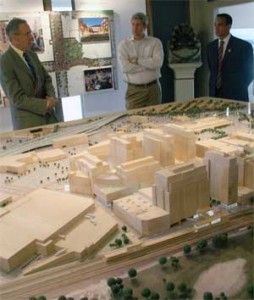
Jeffrey Simon, Director of the Massachusetts Recovery and Reinvestment Office meets with FRIT Executive Don Briggs and Mayor Joseph Curtatone. - Photo By Andrew Firestone
By Andrew Firestone
It has been several weeks now since the DIF vote passed in Board of Aldermen, and the Assembly Square development inches closer to being realized. Jeffrey Simon, Director of the Massachusetts Recovery and Reinvestment Office within Governor Deval Patrick’s cabinet visited the site and toured the “spine of the project,” Assembly Square Drive. The road was part of the 70-acre development that Simon oversaw $12 million of the $14.9 million total funds authorized from federal stimulus monies in the Recovery Act.
He was joined by Mayor Joseph Curtatone and Federal Reality Investment Trust (FRIT) executive Don Briggs, who detailed the progress of the development at their marketing center in the middle of the development. Briggs began by thanking Simon for the funds, which he deemed critical at the time for maintaining the $300-$350 million development.
The tour was an opportunity for Briggs to explain the stages and overall scope of the project and he was diligent in explaining the various ins-and-outs of the area.
“This is a project that from day one has been very important to governor Patrick and it’s one that just goes so far beyond the physical boundaries of the site,” Simon said at the end. “I’m really glad I came,” he added.
“We wouldn’t be here if the stimulus project had not have happened,” said Briggs. “We can walk outside and look at this road that’s built,” referring to Assembly Square Drive. “One of the key selling points when we bring tenants out here is, we open that door right there and you look down Assembly Square Drive, and you kind of get a sense of the scale of what it is we’re creating.”
“We’re coming out of one of the worst recessions this country has felt in a long, long time and we were able to continue to move forward through the depth of that recession,” said Curtatone. “We couldn’t have done it without the Commonwealth’s support.”
For his presentation Briggs used a massive scale model of the plan, and also had a computer graphic depicting an aerial view from the north overlooking the project, with Cambridge and Boston in the background.
Briggs detailed FRIT currently holding 5 million square feet worth of entitlements, with a scheduled 1.75 million sq. ft. of office Space, 1.1 million total sq. ft. of retail space and 2100 planned residential units, with plans to build a movie theater and an entertainment center such as a fitness center or a bowling alley like “Kings” in the Back Bay. He said that in the current market, “retailers are doing business again,” but had nothing to announce coming back from the Las Vegas RECON (Global Retail Real Estate Convention) run by the ICSC two weeks prior.
“Whereas a year and a half ago, you’d come to this site and what you saw was industrial wasteland, underutilized dirt, now you see a road, you see trees, you see edge conditions, you see construction and people begin to believe that this 70-acre site here is really going to turn into something,” said Briggs, crediting the crucial funds from the stimulus.
Curtatone detailed the windfall in terms of the public sector, namely, “that 12 million dollars of public investment has leveraged a billion dollars worth of private investment, tens of thousands of new and permanent jobs here for the long term, 17 million net new money in property tax dollars for the City of Somerville, and millions of dollars in broad base tax revenues for the Commonwealth of Massachusetts.”
“The scale that you’re talking about; particularly with the T stop, you almost have a new town within a town,” said Simon. “The standard of transit-oriented development is the way that, nationally, the entire development community is going.”
As far as the office-space and R&D was concerned, Briggs said that he believed economic trends were in their favor with “significant amenities” that could out-compete their nearest place similar to their overall plan, Cambridge’s Kendall Square, including access to the waterfront and its environment, I-93 and the Orange-Line.
“You can create a campus environment here that provides a strong corporate identity,” said Briggs.
Briggs described why local economic factors favored Assembly Square’s attractiveness to a wide range of businesses. “Historically what has happened is, people have outgrown Kendall Square, they leapfrog out to the 128 belt. There’s a strong technology cluster out in Burlington, out in Waltham, and a lot of that is because there hasn’t been an opportunity like this.”
“If they choose to stay in [near Boston], they can be a whole lot closer to the younger, well-educated population that today is choosing to live in urban environments whereas 10 years ago, 15 years ago they weren’t. It’s not just proximity to your partners but it’s proximity to your employment base.”
Briggs used the example of Palo Alto and its gradual spread throughout the region in southern San Francisco Bay, leading it to become a major economic force with major technology companies. “I actually think that the Boston marketplace is going to go through that same sort of evolution.”
“Before it was going out to the 128 belt and even out to the 495 belt. What you can see happening now is that the 495 belt is collapsing into the 128 belt and what’s going to happen I think over the course of the next 10, 15 years is you’re going to see clusters like Assembly Square, like North Point, like Seaport district, that could potentially take on the kind of density that’s coming out of Cambridge giving these companies an alternative to locating here.”
Briggs said the missing piece to the puzzle was interest from one of Boston’s oldest and most powerful industries. “The venture capital in Boston needs to invest in Boston and needs to be here in Boston and keep those companies here in Boston.”
Simon at one point asked Curtatone if he would call the vote a “hundred year decision” which Curtatone said it indeed was. “This is, in addition to the Green Line, the most important development project in the City’s history. That DIF vote we took a month ago, a month and a half ago, was the most important vote in the City’s history,” said Curtatone.
When Simon asked what response from Somervilliens was, he answered, “there’s a huge demand to build it. They want it built.”
“I particularly have to admire the genuine partnership between the developer and the city,” said Simon after the tour, explaining that it was something he didn’t usually see during his tenure monitoring developments such as the Assembly Square project across the state.
“Developers are the most optimistic people in the world, you have to be, you have to believe in the future to be a developer and that’s true of mayors as well,” said Simon. “But you don’t always get a mayor who can look at a 10-year development with that kind of foresight, and the ability of Mayor Curtatone to be able to look into the future and be able to understand the long-term importance of a project for the City of Somerville, looking at it as a hundred year decision, is incredibly impressive and is probably one of the main reasons why Federal Reality is here, frankly.”
“A lot of people talk about partnership. This is the embodiment of it. If you get this kind of transit-oriented development of the scale that we heard described today, it’ll make a fundamental change to not only the economics of the region but the vitality of the region.”
















Reader Comments